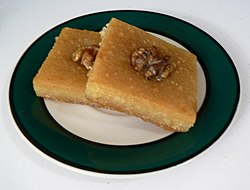This is an old revision of this page, as edited by Northamerica1000 (talk | contribs) at 09:55, 15 July 2014 (→External links: - {{dessert-stub}}). The present address (URL) is a permanent link to this revision, which may differ significantly from the current revision.
Revision as of 09:55, 15 July 2014 by Northamerica1000 (talk | contribs) (→External links: - {{dessert-stub}})(diff) ← Previous revision | Latest revision (diff) | Newer revision → (diff) Basbousa topped with walnut Basbousa topped with walnut | |
| Type | Dessert |
|---|---|
| Region or state | Middle East |
| Main ingredients | Semolina or farina, syrup |

Basbousa (Arabic بسبوسة basbūsah) or hareesa (Arabic هريسة harīsa), shamali (Armenian Շամալի), nammoura (in Lebanon ), revani (from Persian) used in the former countries of the Ottoman Empire: (Greek ραβανί and ρεβανί), revani (Turkish) or ravani is a sweet cake made of cooked semolina or farina soaked in simple syrup. Coconut is a popular addition. The syrup may also optionally contain orange flower water or rose water.
It is found in the cuisines of the Eastern Mediterranean under a variety of names. It appears to be a variant of the Egyptian dish ma'mounia. In southern Greece, it is called ravani, while in the north, it is called revani. It is a traditional dessert in Veria. Basbousa is often called "hareesa" in the Maghreb, Alexandria, and Jordan. Basbousa is a particularly popular dessert among Coptic Christians for fasts such as Great Lent and the Nativity Fast as it is vegetarian.
Pastūsha

Pastūsha (sometimes stylized as Pastūçha) is a variant of basbousa that originated in Kuwait in the 2010s. Like Basbousa, it is made of semolina soaked in sweet syrup. It is characterized by the addition of finely ground pistachios and orange flower water.
See also
References
- http://www.tasteofbeirut.com/2014/07/citrus-bars-nammoura/
- http://www.nisanyansozluk.com/?k=revani&x=0&y=0
- Alan Davidson, Oxford Companion to Food
External links
- How to make Basbousa/Revani, German